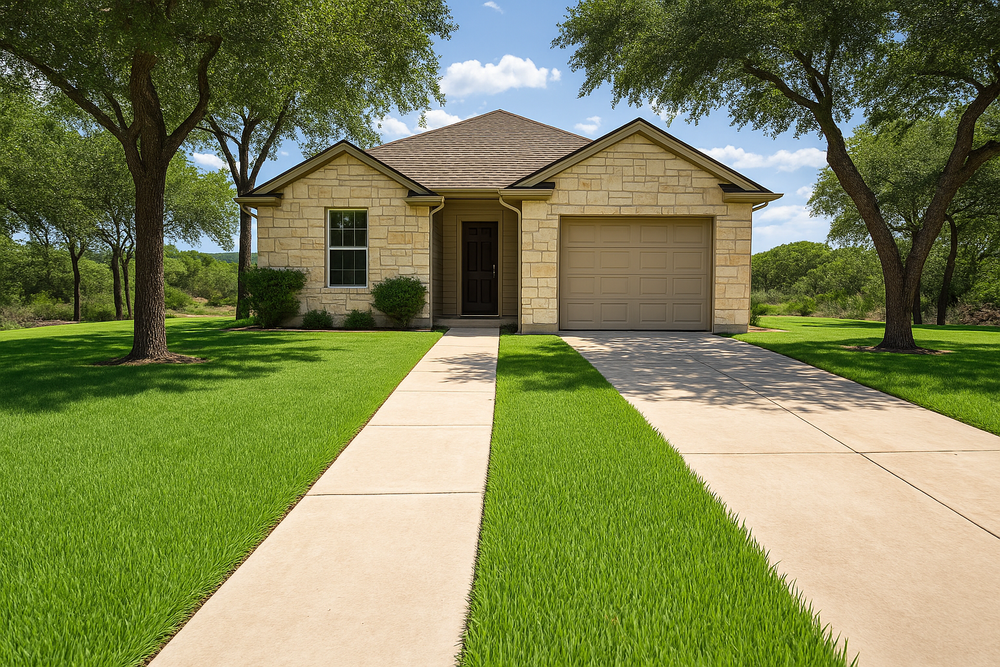Austin Sod Guide | Best Grass Types, Climate, and Lawn Care Tips
Posted by Farm2Yard on Sep 30th 2025
Austin Sod Guide: Best Grass Types, Climate Tips, and Seasonal Lawn Care
If you live in Austin, choosing the right sod is one of the most important steps in creating a lawn that thrives. Central Texas lawns face challenges that range from long, hot summers to occasional drought and heavy spring storms. With the right turf selection and seasonal maintenance, homeowners can enjoy a resilient, green lawn year-round. This guide covers Austin’s climate, the best sod types for the region, maintenance tips for each season, and the best times to lay new sod.
Austin’s Climate and What It Means for Your Lawn
Austin is located in USDA Plant Hardiness Zone 8b–9a, which means winters are mild and summers are long, hot, and dry. Average summer highs regularly exceed 95°F, while winters rarely dip below freezing. The city receives about 34 inches of rainfall per year, but rain often comes in bursts during spring storms or occasional fall showers rather than being evenly distributed.
This climate creates several challenges for lawns:
-
Heat stress: Grass must tolerate prolonged periods of extreme heat.
-
Drought tolerance: Water restrictions are common in Austin, so grasses with lower irrigation needs are favored.
-
Soil conditions: Central Texas soils range from rocky limestone in the Hill Country to heavier clay soils east of the city, which can affect sod establishment and drainage.
For these reasons, homeowners in Austin need turfgrass varieties adapted to warm-season growth, drought conditions, and alkaline soils.
Best Sod Types for Austin
Several warm-season grasses perform well in Austin, each with its advantages depending on shade, soil, and use.
1. St. Augustinegrass
-
Why it works: St. Augustine is one of the most popular grasses for Central Texas because of its good shade tolerance and ability to establish quickly.
-
Challenges: It requires more water than some other species and can suffer in extended drought. It is also vulnerable to pests like chinch bugs and diseases such as gray leaf spot.
-
Extension source: Texas A&M AgriLife Extension – St. Augustinegrass
2. Bermudagrass
-
Why it works: Bermudagrass thrives in full sun and handles heavy traffic well, making it a strong choice for active families. It is highly drought-tolerant once established.
-
Challenges: Poor shade tolerance; requires regular mowing and fertilization.
-
Extension source: Texas A&M AgriLife Extension – Bermudagrass
3. Zoysiagrass
-
Why it works: Zoysia balances good drought tolerance with moderate shade tolerance. It establishes more slowly but creates a dense, fine-textured lawn.
-
Challenges: Slower establishment can make it more expensive to sod; needs careful watering during establishment.
-
Extension source: Texas A&M AgriLife Extension – Zoysiagrass
How Austin’s Weather Impacts Sod Selection
-
Hot summers make drought-tolerant grasses like Bermudagrass and Zoysia more reliable.
-
Shade from mature live oaks and pecans in Austin neighborhoods may push homeowners toward St. Augustine or certain Zoysia cultivars.
-
Water restrictions during dry years highlight the importance of efficient irrigation and selecting grasses that can handle reduced watering schedules.
-
Soil alkalinity means certain fertilizers (particularly nitrogen and iron supplements) may be needed to keep sod healthy.
Seasonal Lawn Maintenance in Austin
Spring (March–May)
-
Begin mowing once grass starts actively growing (usually March).
-
Apply a balanced fertilizer based on soil testing (Texas A&M soil testing services).
-
Spot-treat weeds before they spread.
-
Check irrigation systems before summer heat sets in.
Summer (June–August)
-
Mow frequently but avoid cutting grass too short; keep Bermudagrass at 1–2 inches, Zoysia at 1.5–2.5 inches, and St. Augustine at 2.5–3 inches.
-
Water deeply but infrequently, in compliance with city restrictions. Most warm-season grasses need about 1 inch per week during peak heat.
-
Monitor for pests like chinch bugs and armyworms.
Fall (September–November)
-
Apply fall fertilization to help roots store energy before dormancy.
-
Aerate compacted soil to improve water infiltration.
-
Overseeding with ryegrass is an option for homeowners who want green lawns during the winter months.
Winter (December–February)
-
Warm-season grasses go dormant and turn brown. Reduce mowing and water only during extended dry spells.
-
Protect sensitive turf from occasional frost with proper mowing height and healthy soil fertility.
Best Time of Year to Lay New Sod in Austin
The best time to install sod in Austin is late spring through early summer (April–June) when warm-season grasses are actively growing. This timing allows sod to establish strong roots before the most intense summer heat arrives.
Fall (September–October) can also be a good time for installation, as cooler temperatures reduce stress on new sod while soil temperatures remain warm enough for root development.
Avoid winter installation since warm-season grasses do not establish well during dormancy.
Additional Tips for Austin Homeowners
-
Soil testing: Austin soils often lack certain nutrients. Test every 2–3 years to fine-tune fertilizer applications.
-
Irrigation efficiency: Use smart controllers or drip irrigation to comply with city watering rules. The City of Austin Water Department offers rebates for water-efficient systems.
-
Mulching leaves: Instead of raking, mulch leaves with a mower to add organic matter to the soil.
-
Shade management: Prune trees to reduce dense canopy shade if St. Augustine is thinning.
-
Pest watch: Warm, humid summers encourage pests - stay alert for chinch bugs, white grubs, and fungal diseases.
Conclusion
Creating a lawn in Austin means balancing beauty with practicality. With the right sod choice - whether it’s the durability of Bermudagrass, the shade tolerance of St. Augustine, or the aesthetic appeal of Zoysiagrass - homeowners can enjoy a green yard that withstands Central Texas heat. Pairing smart sod selection with seasonal care ensures your Austin lawn thrives year after year.

